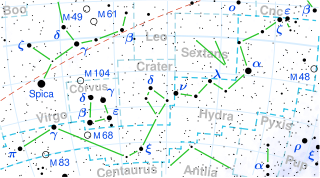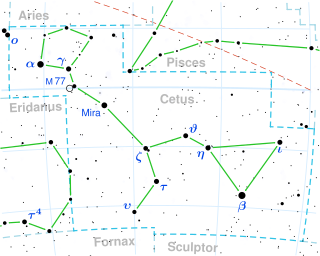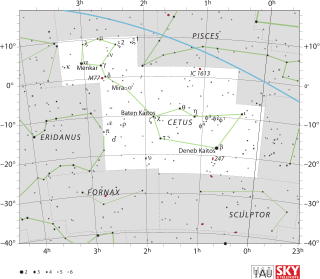
Alpha Herculis, also designated Rasalgethi and 64 Herculis, is a multiple star system in the constellation of Hercules. Appearing as a single point of light to the naked eye, it is resolvable into a number of components through a telescope. It has a combined apparent magnitude of 3.08, although the brightest component is variable in brightness. Based on parallax measurements obtained during the Hipparcos mission, it is approximately 360 light-years (110 parsecs) distant from the Sun. It is also close to another bright star Rasalhague in the vicinity.

Alphard, designated Alpha Hydrae, is the brightest star in the constellation of Hydra. It is a single giant star, cooler than the Sun but larger and more luminous. It is about 177 light-years away.

Beta Pegasi, formally named Scheat, is a red giant star and the second-brightest star in the constellation of Pegasus. It forms the upper right corner of the Great Square of Pegasus, a prominent rectangular asterism.

Beta Ceti, officially named Diphda, is the brightest star in the constellation of Cetus. Although designated 'beta', it is actually brighter than the 'alpha' star in the constellation, Menkar, by half a magnitude. This orange giant is easy to identify due to its location in an otherwise dark section of the celestial sphere. Based on parallax measurements, it lies at an estimated distance of 96.3 light-years from the Sun.

Alpha Sagittarii, also named Rukbat, is a star in the constellation of Sagittarius.

Alpha Crateris, officially named Alkes, is a star in the constellation of Crater. It is a cool giant star about 43.2 parsecs (141 ly) away.

Zeta Ceti is a binary star in the equatorial constellation of Cetus. It has a combined apparent visual magnitude of 3.74, which is bright enough to be seen with the naked eye. Based upon parallax measurements taken during the Hipparcos mission, it is approximately 235 light-years from the Sun.
Iota Ceti is the Bayer designation for a star system in the equatorial constellation of Cetus. It has the traditional name Deneb Kaitos Shemali. The name was from the Arabic word ذنب قيطس الشمالي - dhanab qayṭas al-shamālī, meaning the northern tail of the sea monster. it is visible to the naked eye with an apparent visual magnitude of 3.562. Based upon an annual parallax shift of 11.7 mas, it lies around 280 light years from the Sun.

Gamma Ceti is a triple star system in the equatorial constellation of Cetus. It has a combined apparent visual magnitude of 3.47. Based upon parallax measurements, this star is located at a distance of about 80 light-years from the Sun.

Delta Ceti, Latinized from δ Ceti, is a single, blue-white hued star in the equatorial constellation of Cetus. The star's apparent visual magnitude of +4.06 means it is near to the cusp of the faintest third of the stars that are visible the ideally-placed naked eye. It is 0.3238° north of the celestial equator compared to the celestial north pole's 90°. The star is positioned about 0.74° WNW of the spiral galaxy M77, but which at apparent magnitude 9.6 needs magnification to be made out and has an apparent size of only 0.1° by 0.12°.
Theta Ceti, Latinized from θ Ceti, is a solitary, orange-hued star in the equatorial constellation of Cetus. It is visible to the naked eye with an apparent visual magnitude of 3.60. Based upon an annual parallax shift of 28.66 mas as seen from Earth, it is located about 114 light-years from the Sun. At that distance, the visual magnitude is diminished by an extinction factor of 0.10 due to interstellar dust.

Upsilon Ceti, Latinized from υ Ceti, is a solitary star in the equatorial constellation of Cetus. It is visible to the naked eye with an apparent visual magnitude of 3.95. Based upon an annual parallax shift of 11.14 mas, it is located about 293 light years from the Sun.

Lambda Ceti, Latinized from λ Ceti, is a B-type star of fifth-magnitude located in the constellation Cetus. Historically, the star bore the traditional name Menkar, although today that name is more commonly associated with α Ceti.

Mu Ceti is a star in the constellation Cetus. The combined apparent magnitude of the system is +4.27, and it is located 84 light-years from the Sun.

ν Ceti, Latinized as Nu Ceti, is a binary star system in the equatorial constellation of Cetus. It is visible to the naked eye as a faint point of light with a combined apparent visual magnitude of 4.86. The system is located approximately 340 light years distant from the Sun, based on parallax, and is drifting further away with a radial velocity of 4.8 km/s. Nu Ceti is believed to be part of the Ursa Major stream of co-moving stars.

Xi1 Ceti , Latinized from ξ1 Ceti, is a binary star system located in the equatorial constellation of Cetus. It is visible to the naked eye with a combined apparent visual magnitude of +4.36. The distance to this system is approximately 340 light years based on parallax measurements, and it is drifting closer to the Sun with a radial velocity of −4 km/s. The proximity of the star to the ecliptic means it is subject to lunar occultations.
Xi2 Ceti, Latinized from ξ2 Ceti, is a star located in the equatorial constellation of Cetus. It is visible to the naked eye with an apparent visual magnitude of +4.3. This star is located at a distance of approximately 197 light years from the Sun based on parallax, and is drifting further away with a radial velocity of 12 km/s. It made its closest approach some 2.7 million years ago at a distance of around 128 light-years.
Sigma Ceti is the Bayer designation for a star in the equatorial constellation of Cetus. With an apparent visual magnitude of 4.78, it can be seen with the naked eye on a dark night. Based upon an annual parallax shift of 37.46 mas, it lies at an estimated distance of 87.1 light years from the Sun. It is a probable astrometric binary star system.

Chi Ceti , is the Bayer designation for a double star in the equatorial constellation of Cetus. They appear to be common proper motion companions, sharing a similar motion through space. The brighter component, HD 11171, is visible to the naked eye with an apparent visual magnitude of 4.66, while the fainter companion, HD 11131, is magnitude 6.75. Both lie at roughly the same distance, with the brighter component lying at an estimated distance of 75.6 light years from the Sun based upon an annual parallax shift of 43.13 mass.
75 Ceti is a single star in the equatorial constellation of Cetus with at least two planets. It is visible to the naked eye as a dim, orange-hued star with an apparent visual magnitude of +5.36. The star is located 268 light-years distant from the Sun, based on parallax, but is drifting closer with a radial velocity of −6 km/s.









